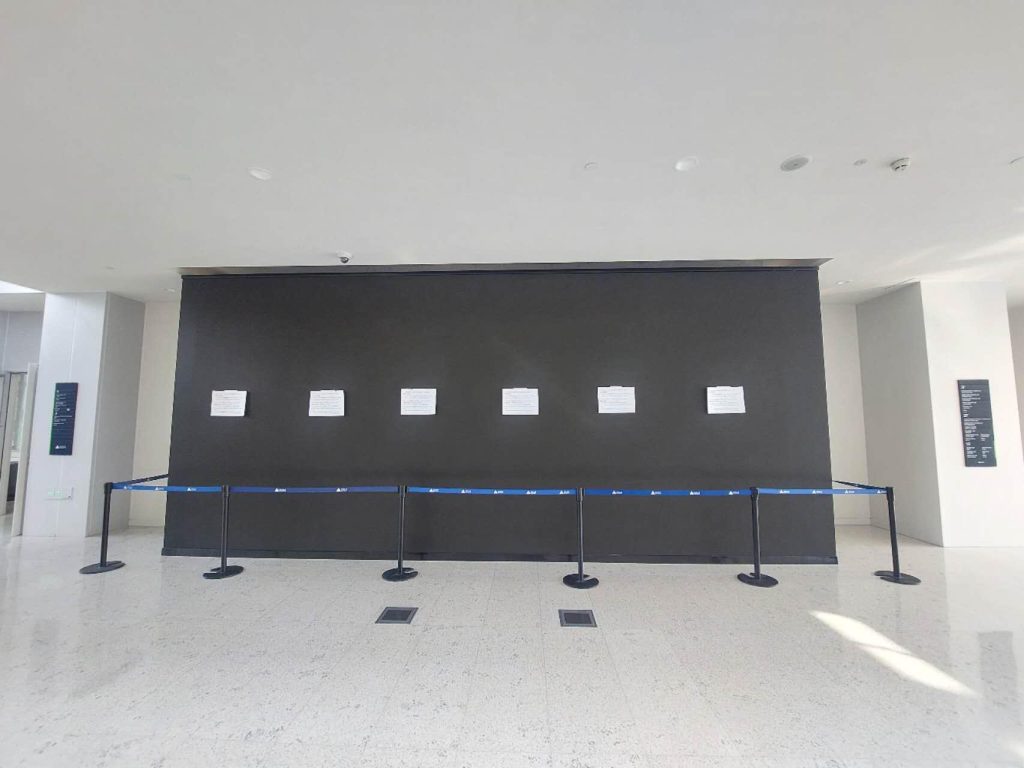The video on display LAST WEEK was super DISTURBING
This article is going to make you angry (in some way or another). I want it to. I want you to feel a burning, seething, pent-up hellfire of aggression and distaste. And then I want you to scream and shout. I want you to let out all of your passion, all of your hatred. And then I want you to move on.
On Thursday, February 8th, an anonymous person posted the following message on the recently added Innovation Building electronic displays:


Photos by DKU senior
This note (a total of 6 of them) was plastered across the art display of 杨振中 Yang Zhenzhong’s “消毒 Disinfect”, a feature of 18 individuals as they scream, cry, and belittle the viewer. I’m sure you, the reader, may have seen these figures on your way into the IB’s lobby. They are disturbing. They are surprising. They clearly made people angry. It is effective art, and that makes it beautiful. For reference, Yang Zhenzhong has been making visual mediums since 1994. He is a renowned creator, known for his conceptual pieces. “Disinfect” is no different and hence, Yang Zhenzhong’s vision deserves to be respected.
Why do we fear negative emotions?
Stop Being Negative About Negativity
The plastered note references “NEGATIVE scenarios” in a, well, negative manner. In fact, most of society is so quick to view something that’s “negative” as inherently bad. Yet, Yang Zhenzhong seems to see it as anything but, making it a display to be enjoyed. How do we find enjoyment from negativity? While it seems counterintuitive, it is already rather undisputed that negativity has the potential to be attractive. Think of how negative news in the media tends to receive more attention (“if it bleeds, it leads!”), or how it can be so easy to stream sad songs when feeling down. Negativity, when given attention, becomes a comforting blanket that provides a familiar feeling. Playing sad songs when feeling a melancholy dread gives the mind a resting place to wallow, whereas playing happy songs may disrupt the mood, or even cause greater feelings of anger. Indeed, it isn’t the negative feelings that are the problem. It’s the imbalance between their expression and the expression of happy feelings.
The note clearly states the author’s perspective: “[the video] is just the OPPOSITE of any culture in a holiday.” To the author, it is appalling to see such a heinous sight on such a seemingly joyful occasion. This view, however, not only clearly associates “negative” with “bad” but causes a great disconnect between the expression of happiness and the expression of dread. Far too often are we all quick to seek the “happy” moments that we forget to balance them with the exemplification of sadness. Assuming that Chinese New Year (or any holiday for that matter) is a moment of guaranteed joy almost paints it as a required time of elation, as if life is inherently sad and the New Year is a break from that. This perspective is saddening in itself, and I fear that it lies dormant in the subconscious of individuals far more often than it should.
Balance
Life is not sad. It isn’t happy either. It’s a pendulum that rotates in three dimensions with multiple balls being swung at once. To simplify points of time (such as New Year’s) to specific emotions is reductionist in nature. It does a great disservice to ourselves, who are complex beings with multifaceted responses. Simplifying our emotions to specific emotions has the same effect. Indeed they are very, very, very complex. This is why we sometimes feel bittersweet when someone leaves for a new adventure; you’re hurt by their absence but overjoyed by their future explorations. Or when you find pleasure in the pain of working out, knowing that your body is improving. Sad songs when you’re sad lead to gradual happiness while happy songs when you’re happy may bore you. Emotions coexist and to block certain ones out is counterintuitive at best and life-threatening at worst.
Yang Zhenzhong’s art piece is art, whether you appreciate it or you don’t. My view? The failure of his art piece is that it only displayed pain and sorrow, as if that’s the only emotion that humanity needs reminding of. The note is wholly wrong too; there is beauty in sadness. If one views Yang Zhenzhong’s display for long enough, they would gradually realize that the 18 individuals aren’t spewing negativity to be negative, but are doing so in the prospect of finding positivity. Emotions aren’t simple, and so we must be careful when trying to paint them as such. As such, be angry. I want you to be angry. I want you to feel a burning, seething, pent-up hellfire of aggression and distaste. And then I want you to scream and shout. I want you to let out all of your passion, all of your hatred. If you disagree with me, scream at me. Write a response for The Lilypad and challenge me. If you’re super happy, write about that too! Tell others. Don’t restrain certain emotions. Be angry. And then I want you to move on. And then I want you to be happy too. Then maybe a little sad. Then maybe both at once.

